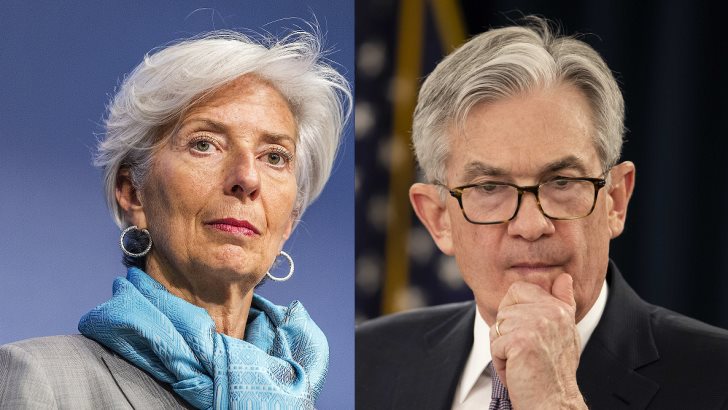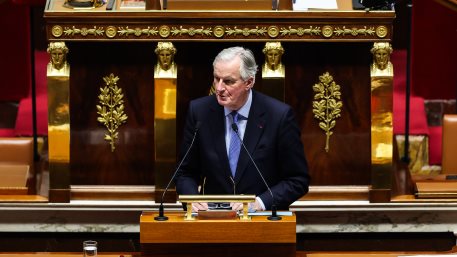
The coronavirus pandemic is a healthcare crisis the likes of which the WHO feared for a long time, but still cannot fully understand. Due to its peculiarities, the SARS-Cov-2 virus affects different peoples in different ways, which makes the study and containment of the pathogen a palpably arduous task. While many epidemiologists are still perplexed by the heterogeneous nature of the virus, the depth of the economic fallout triggered by the pandemic has been equally as erratic across the globe.
While no country has been left unscathed by the global economic downturn, the breadth of the financial blows has not been the same everywhere. Unsurprisingly, the monetary policy responses by the most significant central banks have been similar in execution, but different in scope. This, in turn, creates a precedent for an even and protracted global recovery.
The two most significant central banks in the world – the European Central Bank and the Federal Reserve – both have stated that the complete range of available tools under their disposals have been fully utilised, in order to offset the negative impact of the fallout and to accommodate future recovery.
It is the minor discrepancies between the selected approaches by the two bodies that are going to underline the future pace of economic recovery, which is why it is prudent to review the three most substantial differences in the two central banks' responses to the coronavirus crisis so far.
3. Evaluating the remaining risks from the still looming uncertainty
The Governing Council of the ECB and the Federal Open Market Committee (FOMC) of the FED have both cautioned against the economic risks from a protracted healthcare emergency. A potential resurgence in the global infections rate could roil the very fragile recovery process, which is still in its early stages.
Hence, the uncertainty stemming from the unpredictability of the pandemic's nature casts a shadow over the continuous efforts to ensure sustainable economic stabilisation. The two central banks have evaluated this uncertainty subjectively, which is reflected upon their separate responses to the underlying risks.
The FOMC has been somewhat more ambiguous in its remarks concerning its expectations for the length and duration of the anticipated economic recovery. Following the conclusion of the Committee's last meeting in late-April, Chair Jerome Powell stated that:
" The Committee expects to maintain this target range until it is confident that the economy has weathered recent events and is on track to achieve its maximum employment and price stability goals."
Powell, however, refrained from providing any conceivable timeframe in which the Committee expects to observe a noticeable improvement in the underlying economic conditions resulting from FED's actions. Evidently, Powell and the rest of the Committee are choosing to maintain some level of flexibility for the future, by abstaining from providing more intricate projections. Such strategic vagueness could prove invaluable in case that the healthcare crisis does indeed deepen, which, in turn, would lead to another downward revision of the underlying economic conditions. However, the trade-off is that investors have fewer reasons to be optimistic about the FED's belief in the robustness of its own policy in the short run.
In comparison, the Chair of ECB's Governing Council Christine Lagarde sounded much more complacent during her speech yesterday. She said:
"Our crisis-related measures are temporary, targeted and proportionate. Their temporary nature is reflected, for example, in the net purchase horizon of the PEPP, which is expected to run at least until the end of June 2021, and in any case until the Governing Council judges that the coronavirus crisis phase is over."
Such forward-looking comments encapsulate a bit of a gamble for the ECB. On the one hand, they are ensuring of the durability of the Bank's recent monetary policy adjustments. On the other, investors' potential disappointment with the ECB's short sidedness could be amplified drastically, in case that the scope of the PEPP relief package has to be extended beyond the aforementioned target date. Such a scenario could unfold if the pandemic remains a significant threat to economic stability past the second quarter of next year.
In summary, the cautious FED prefers to leave itself plenty of room for future readjustments (if the underlying conditions deteriorate significantly). In contrast, the daring ECB tries to provoke economic stabilisation by motivating investors and spenders in the short term.
2. Facing different political landscapes
On the surface level, the ECB and the FED both serve the same purposes in their respective regions – they are meant to ensure maximum employment, healthy inflation around 2 per cent, and sustainability of the financial markets. Nevertheless, the unprecedented nature of the coronavirus crisis is causing external pressures for the two bodies, which are now forced to consider various political factors in addition to their typical considerations of the underlying economic data.
Donald Trump has targeted Jerome Powell and the rest of the Committee in the past for the way in which they were conducting FED's monetary policy. While some critics have reprimanded the President's arguments as a breach of his own jurisdictions, for Powell and the rest of the FOMC it should be clear that FED's response to the COVID-19 crisis today could come under scrutiny tomorrow. Due to such political charges, the Committee has to make sure that its monetary policy can withstand external pressures in addition to its regular task of ensuring favourable conditions for the prosperity of the American economy.
In Europe, the political landscape is different. In the early days of the crisis when it was becoming clear to many that the breadth of the economic contraction is going to be quite substantial, many started to fear these ripples could shake the very foundations of European cohesion. Some even expressed concerns that the European Union may not survive the pandemic as a singular political entity.
That is why the ECB and the EU Commission were tasked with finding a way to galvanise the tools under their disposals in order to avoid such gloomy prospects. Lagarde's speech from yesterday resonated over these concerns:
" European spending will be most effective if its focus is on projects that add real value from a European perspective. The primary common interest is to reduce the fragmentation stemming from the present crisis and divergence in the longer run."
The most substantial inference that can be drawn from these observations is that the focus of the two central banks is not entirely concentrated on economics, as it should normally be. Instead, they are compelled to consider the political ramifications from their actions as well, which could have profound implications for the success of the two respective monetary policies in the long run.
1. Purpose vs Structure of the underlying monetary policies
The most significant difference between the two banks' responses to the current crisis is manifested by the diverging emphases they make.
Jerome Powell explicitly underlined the inherent purpose of FED's various asset purchasing programs during his last speech. He placed special emphasis on the nature of monetary policy as a whole with particular attention to how and under what conditions borrowers can benefit from the credit lines that are extended by the Bank:
"[..] I would stress that these [FED'S various programs] are lending powers and not spending powers. The Fed cannot grant money to particular beneficiaries. We can only make loans to solvent entities with the expectation that the loans will be repaid. Many borrowers will benefit from our programs, as will the overall economy. But for many others, getting a loan that may be difficult to repay may not be the answer. In these cases, direct fiscal support may be needed."
Powell drew a clear and concise dividing line between FED's monetary policy and the US Government's fiscal policy. In doing so, the Chair of the FOMC distinguished between the primary roles of the two instruments. Powell's remarks underpin the need for the two policies to work in conjunction with each other as opposed to functioning in a vacuum, which is the only way to safeguard a sustained economic recovery.
In contrast, Lagarde's statement from yesterday somewhat departs from Powell's central point:
"They [ECB's measures] are targeted to the specific shock and contingency at hand, aimed at repairing the economic hardships wrought by the pandemic. And they are proportionate to the severe risks to our mandate that we are facing. […] Finally, our decisions will make sure that higher borrowing needs by fiscal authorities associated with the necessary fiscal response to the crisis will not translate into materially higher interest rates for the private sector."
The focal point of her assertion is concentrated on the underlying structure of ECB's asset-purchasing programs more so then it is on the purposes they serve. This is unlike Powell, who stressed on the 'lending' nature of FED's policy. This distinction underlines the priorities of the two bodies.
On the one hand, the more circumspect FED stresses on the full extent to which its monetary policy can be utilised in the present situation. This is yet another confirmation of FED's determination to leave itself some room to manoeuvre in the future if need be.
On the other hand, ECB's emphasis is placed yet again on the present. By stressing on the particular structure of its monetary framework, the Governing Council of the Bank evidently wants to project determination and resourcefulness. Both of which presumably are meant to stimulate pickup in the underlying economic activity in the short run.
Both banks are taking certain risks, and the differences between their respective monetary policies are going to yield different results. It remains to be seen whose approach would be more effective under its own context.




















